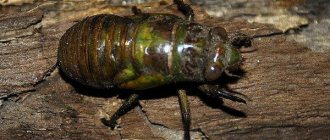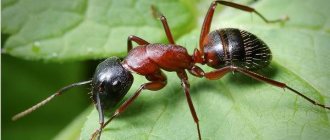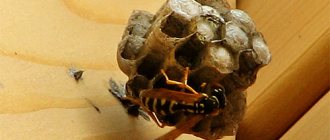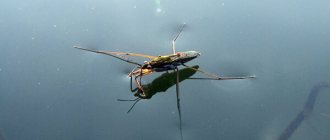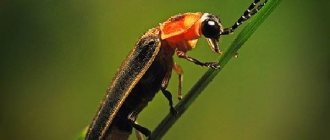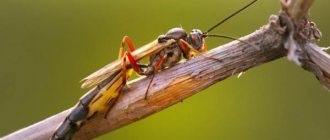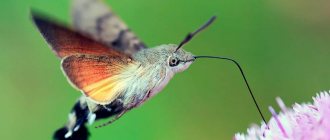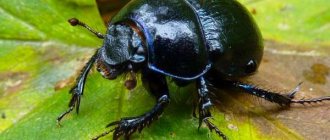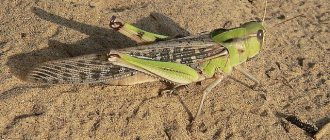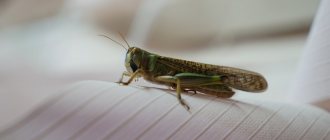If you look at a photo of a praying mantis, you can see an insect with its front legs folded at the elbows; its pose resembles a person reciting a prayer. This is where its name comes from.
The Latin name, Mantis religiosa, was given to it by the scientist Carl Linnaeus, drawing attention to its posture during an ambush. Translated, this means “religious priest.” This name has come down to us as “mantis”.
There are other names for this insect, for example, the Spaniards call it the devil's horse, apparently it received this name for its creepy habits.
Mantis coloring
The color of these insects depends on the conditions in which they live. Thus, mantises living among greenery are green in color, while those living on the ground are brown.
Thanks to their camouflage color, they can sit in ambush for a long time, waiting for their prey and attacking unnoticed. They rarely leave their habitats, only in cases of lack of food.
Description
The common mantis is a fairly large insect, 40-76 mm long. Females are noticeably larger than males. The color of the integument varies from green to dark brown. Well-developed elytra are longer than the abdomen. The wings are transparent, greenish or brownish at the tip. The head is triangular and can rotate 360°. The forelegs are grasping, with long coxae and tibiae ending in sharp spines, which are designed for grasping prey.
Enemies of Mantises
There are many enemies in the wild and among praying mantises. They can be bats, birds, snakes. Very often they are eaten by their fellows. Battles between praying mantises or other enemies can be very spectacular.
In case of danger, the mantis spreads its front legs and spreads its wings, showing all its brightly colored parts. At the same time, its wings can make a rustling, frightening sound.
What do they eat?
It is important to know what the praying mantis eats. In its natural habitat, other insects become its food. Praying mantises are omnivores - they eat bees, wasps, bumblebees, mosquitoes, butterflies, and various beetles with equal pleasure. Large individuals are capable of attacking small amphibians, rodents (lizards, mice) and even small birds.
The praying mantis attacks from ambush. He patiently waits for the victim, then grabs it with his forelimbs and, holding it, eats it. Nature has endowed them with powerful jaws, allowing them to gnaw even the largest prey.
Benefits and harms for humans
The insect behaves quite aggressively, so many people have a fear of it. Moreover, many representatives are large in size.
The question arises, why is the praying mantis dangerous for humans? The praying mantis does not pose a serious threat to humans, but can easily injure with its claws. To avoid trouble, you should not let small children near it, because the habits of the insect are far from angelic.
By eating many pests, the predator benefits agriculture, but at the same time it also destroys beneficial insects, such as bees.
Life cycle
During the mating season, the male praying mantis carefully approaches the female, trying to determine how full she is. The mating process lasts from several tens of minutes to several hours. The fertilized female lays eggs in separate portions containing from 70 to 300 eggs, and places them in a special capsule - the ooteca. After 5-7 weeks, larvae appear from the eggs, similar to adult insects. As soon as they are born, they immediately begin their first molt, and two days later they begin to actively feed, molting every 10-12 days. At this time, they feed on aphids, small insects, and can even devour each other. After 10-15 weeks, the larvae develop into adult mantises. Eggs laid in autumn overwinter in capsules, and the larvae emerge from them in late spring.
Photos of praying mantises
Keeping at home
can live up to 1.5 years at home But they need appropriate conditions.
Terrarium
These insects require a small glass terrarium. Experts advise choosing it according to the size of your pet. It should be 3 times the length of the mantis in height. Inside the terrarium, twigs (artificial and live), moss, leaves, and coconut substrate are placed.
Conditions of detention
When choosing a terrarium, take into account the conditions of detention:
- Temperature. It should be between +25°C and +30°C. If necessary, additional heaters are used.
- Humidity. Praying mantises love high humidity, so the levels should be around 60%.
- too many praying mantises . One individual is enough in one terrarium, otherwise they will start eating each other.
Beginning praying mantis owners often have a question about how to determine the sex of a common mantis . As a rule, females are always significantly larger than males. In addition, it is possible to determine whether an insect belongs to one sex or another by the last segments.
Nutrition
Another problem is what to feed the praying mantis at home. This insect naturally hunts and immediately eats its prey. Therefore, it is recommended to feed the praying mantis in a terrarium with live food. Owners use aphids, locusts, grasshoppers, cockroaches, and various larvae. Some species happily feed on ants.
Nymphs are fed daily, adults are given food once every few days. The amount of food should correspond to the size of the insect. The praying mantis drinks water that is sprayed on the plants in the terrarium. It gets some of its moisture from food.
The mantis, the harm or benefit of this insect, has long been known.
As a predator, praying mantises support the natural abundance of insect pests in nature. But if there are too many praying mantises, they can destroy many beneficial insects (bees, etc.). Post Views: 491
Nutritional Features
The praying mantis is a predator that consumes only living creatures. Not a single representative of this genus hunts carrion. Insects eat a lot, they are constantly looking for food. Main components of the diet:
- flies, beetles, hornets and other insects;
- amphibians, rodents, reptiles;
- relatives.
A short story about the praying mantis should contain information about the diet of these predators. Their species suffers from cannibalism. The older generation can eat the young, and fights between males usually end in a feast.
Insects are not used to running for a long time after their prey. Thanks to their special color, they skillfully hide among flowers and trees, wait for prey, and then very quickly rush at it from ambush. With their large forelimbs they grab the prey, squeeze it between the ribs and begin to slowly eat. The specific structure of the mouthparts with strong jaws allows them to tear off small pieces of prey.
Dimensions
We have already mentioned above that female praying mantises are much larger than males, oddly enough, this is where their main sexual difference manifests itself.
A species of praying mantis, called Ischnomantis gigas in Latin and living in Africa, can reach 17 cm in length; perhaps this representative of the praying mantis kingdom is a real record holder in size.
Ischnomantis gigas is the largest praying mantis in the world.
It is slightly inferior to Heterochaeta orientalis or Heterochaeta eastern, it reaches 16 cm in length. Ordinary mantises are much smaller in size, on average no more than 0.5-1.5 cm in length.
Habitat
The habitat of mantises is extensive. They live in Asia, Europe, South America, Africa. Large populations are found in Portugal, Spain, India, and Cyprus. Several species live only within the borders of one country:
- Russia;
- Germany;
- Azerbaijan.
Over time, predators appeared in Australia and North America.
Praying mantises prefer tropical and subtropical zones. They settle in humid forests and deserts, arid steppes and meadows. Heat-loving insects often fly from one country to another to get food, but they do not like to change their place of residence. Predators choose a branch or tree and try to stay there until death. They are active only before mating, during mating games, in case of danger or due to lack of food.
Predators do not need liquid; they receive the moisture necessary for the body along with food. Under natural conditions, these insects are quite cruel. Larger individuals drive out smaller ones and even exterminate them.
Interesting Facts
If you thought that the praying mantis is a harmless and very calm insect with a passive demeanor, then get ready to learn something new about them. Researchers have discovered that these aggressive carnivorous insects kill and eat not only small reptiles such as frogs and lizards, but also small birds. A study by an international team of zoologists has documented this behavior in praying mantises around the world.
It is noteworthy that in general this behavior of mantises was not special. A YouTube search easily turns up a selection of videos showing a praying mantis eating a hummingbird. A new study by a team of zoologists systematically documents 147 examples of attacks by praying mantises, representing 12 different species, on small birds. Scientists tracked the behavior in 13 countries, finding that praying mantises preyed on 24 species of birds.
Interestingly, more than 70 percent of documented cases have been recorded in the United States, and the majority of victims are hummingbirds. Praying mantises have been used in gardens for decades as biological pest control agents, and to this day, many Americans still use both imported and native species for pest control. But new research shows the insects also pose a threat to small passerine birds. In addition, such inselectivity of mantises makes them not the best means of fighting insects.
Video
Origin of the species
In an essay or report on the praying mantis for grade 3, you can write information about the origin of the insect. This is not just a species, but an entire suborder, the representatives of which biologists number about 2000. They have the same habits, a similar body structure, but there are differences in color and size. Praying mantises are predatory insects. They are very voracious and ruthless, slowly finishing their prey, getting pleasure from this process.
The insects got their name in the 18th century, when they were studied by Carl Linnaeus. Translated from Latin, it means “religious priest.” The praying mantis received this name because of its unusual posture during an ambush. In Spain it is known as the "devil's horse".
Some scientists believe that praying mantises evolved from cockroaches, while others argue that they had a separate evolutionary path.
Lifestyle
The lifespan of praying mantises ranges from several months to a year. They are active mainly during daylight hours, when they hunt. Most photos show the praying mantis in its signature hunting pose, in which it remains for a significant part of the day. While waiting for prey, it remains motionless, which is why it merges with the nature around it and becomes invisible both to future prey and to other predators.
If there is enough food in the place where the mantis lives, it may not leave it throughout its life. This insect moves reluctantly, mainly at night. With the help of its wings, it is able to cover short distances, for example, fly to a neighboring tree or climb to a higher branch.
